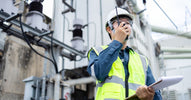
What’s a Duplexer and Why It Matters in Radio Systems
, by Joseph Gabriel, 6 min reading time

, by Joseph Gabriel, 6 min reading time
Reliable radio communication is necessary in many industries, from emergency response teams to transportation and construction crews. At the center of all this communication is a small but powerful device called a duplexer. It’s a great addition that many don’t know about, but understanding what a duplexer is and why it matters in radio systems can make a big difference when setting up or maintaining your equipment.
A duplexer is like a traffic director for radio signals. It allows a single antenna to handle outgoing (transmit) and incoming (receive) signals without them interfering with each other. Imagine trying to talk and listen at the same time on the same phone line, without a duplexer, the signals would overlap and disrupt communication.
The duplexer ensures each signal stays out of the other’s way by separating the signals based on frequency or timing. The duplexer routes the signal to the antenna for broadcasting when a user presses the push-to-talk button on a radio. At the same time, it stays ready to pick up incoming messages. This fast switching gives the feel of a two-way conversation without delay.
There are two main ways duplexers manage the flow of signals: Frequency division and time division.

Using a duplexer brings several advantages to any radio setup. For starters, it cuts down the number of antennas needed. Without one, a system would require separate antennas for sending and receiving signals, which would take up space and add to the cost and complexity of installation. With a duplexer in place, systems become more compact and easier to manage.
Duplexers also improve signal clarity by keeping outgoing and incoming signals separate. They reduce interference and signal “crosstalk,” when signals bleed into one another. This cleaner connection results in better sound quality, a wider communication range, and more dependable performance, especially important in high-stakes environments.
Not all duplexers are the same. Different designs suit different needs, depending on space, power, and performance requirements. Consider the following types:
Emergency services rely on duplexers as part of the unseen infrastructure that keeps teams connected. Police, firefighters, and paramedics rely on dependable communication in life-threatening situations. A working duplexer keeps radio lines open and clear, even during high-volume use.
Commercial industries also count on duplexers every day. In construction zones, warehouse operations, manufacturing plants, and across large transportation networks, smooth communication helps teams stay organized and avoid downtime. Duplexers allow workers to communicate quickly and clearly, even in noisy or complex environments.

Getting the best performance from a duplexer starts with choosing the right one for your radio system’s frequency range and power level. The transmit and receive frequencies need enough separation to avoid interference, and the duplexer must handle the power your system puts out.
Environmental conditions are also something to consider. Duplexers work best in areas protected from extreme temperatures, moisture, or vibration. Proper grounding and neat cable management reduce signal problems and increase lifespan.
Regular checks keep duplexers running as they should be. Look for loose connections, corrosion, or any physical wear. Cleaning should follow the manufacturer’s instructions, since improper handling could damage sensitive parts inside.
If communication starts to drop in range or clarity, the duplexer could be the cause. Other signs include static, echo, or one-sided conversations. These issues often require a professional to diagnose and repair. Trying to fix a duplexer without the right tools or knowledge can lead to further damage or lost warranty coverage.
Duplexer prices vary based on performance, construction, and frequency support. Basic models for light use cost much less than heavy-duty units designed for emergency services or industrial networks.
Beyond the purchase price, you should also factor in the cost of installation, ongoing maintenance, and how long the unit will last. A well-built duplexer can deliver solid service for years. In comparison, a cheaper model may need early replacement or more frequent repairs, leading to higher costs in the long run. The cost of missed or failed communication can far outweigh the price of a reliable duplexer for many organizations, especially during emergencies or peak operation hours.
Duplexers evolve as digital radio systems grow more advanced. New designs support faster data, better sound quality, and more flexible setups. These changes benefit industries that rely on complex communication systems.
One major trend is software-defined radios. These systems use software to control hardware functions, including duplexing. Future duplexers may adapt on the fly, adjusting their behavior based on user needs or system conditions. This adaptation could change the design of radio networks, especially in environments that demand constant adaptability.
The right duplexer depends on several factors, including operating frequency, power output, environmental demands, and budget. Knowing what the system needs will make the choice much easier.
Professional guidance can be valuable during this process. Technicians can look at an existing setup, spot any weak points, and recommend upgrades or replacements that improve performance without going over budget. For more advanced or custom systems, you need this kind of support to avoid problems down the road.
Understanding what a duplexer is and why it matters in radio systems allows for smarter decisions when building or upgrading communication setups. A dependable duplexer improves signal quality, simplifies your setup, and supports smooth day-to-day operations, whether you’re part of an emergency response team or managing a warehouse crew.
Atlantic Radio Communications provides expert advice, top-quality equipment, and full support services for those ready to boost their radio communication system with the right duplexer. Contact the team to find the best fit for your setup and start improving your radio communication equipment today.